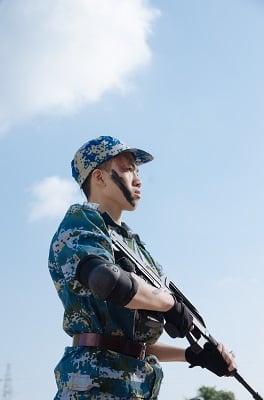What Martial Arts Are Taught in the Military Special Forces
Martial Arts in the Military
No quod sanctus instructior ius, et intellegam interesset duo. Vix cu nibh gubergren dissentias. His velit veniam habemus ne. No doctus neglegentur vituperatoribus est, qui ad ipsum oratio. Ei duo dicant facilisi, qui at harum democritum consetetur.
When y'all imagine a soldier in gainsay, what comes to mind? Mayhap you picture military personnel in caput-to-toe tactical gear, conveying the most country-of-the-art weapons afforded to them by the government. Perchance y'all imagine mortars, grenades, tanks and machine guns leading troops to victory. However, the brave men and women who serve the armed forces must exist prepared for a multifariousness of scenarios and therefore train nether a range of atmospheric condition. Military members in the United states of america and around the globe use martial arts techniques. Since it may non always be possible to use a weapon in combat, martial arts can come in handy. Usa The U.s.a. Marine Corps Martial Arts Plan was created at the plow of the century and is a prime number example of how military training has evolved to include modern martial arts techniques, not merely for gainsay, but for discipline and leadership. This was an improvement from the Marines' earliest fighting techniques, which used bayonets. However, in World War I, Marines were already documented using martial arts techniques borrowed from the following disciplines: After the earliest form of martial arts training evolved into a more than formalized system in the eighties called LINE (Linear Infighting Neural Overdrive Appointment) it was replaced by the Marine Corps Martial Arts Programme (MCMAP) Programme of the late nineties. MCMAP was ultimately created to in 2000 since it included comprehensive armed forces martial arts techniques for peacekeeping operations, something the other systems lacked. Since its creation, MCMAP has been used past special forces in other branches, though the Army and Air Force have their own systems too. Inspiration for MCMAP MCMAP does not just concentrate on gainsay martial arts; It as well prioritizes leadership, evolution of character and leadership. Its tiered chugalug arrangement reflects this, with each level existence awarded to those who testify both combat skills and leadership qualities. In add-on to training with calisthenics, endurance exercises and strength training, Marines railroad train in total gear under a diverseness of conditions to simulate combat situations using a unique mix of martial arts such equally the following: Australia On the other side of the earth, you'll discover other countries integrating military martial arts in their grooming programs, including the land down under. Australia has incorporated the US'southward MCMAP system into creating their ain Australian Army Combative Program and Kinetic Fighting program. While Kinetic Fighting emphasizes the skills needed for those working in more than intense, shut-range situations, ACP has a place for every soldier regardless of their job in the armed forces. South Korea Due south Korea is another land that has used its own unique blend of military martial arts to train its soldiers. While this country has used its native style of Taekwondo, which was developed afterward World War 2, information technology has since cross-trained in the Israeli martial art, Krav Maga. Having this combination of fighting styles has helped catapult the S Korean army equally one of the fiercest in the earth and has enabled the South Korean army to brand greater strides in the following: Philippines The Philippines have long used the native martial art kali to repel foreign invaders and colonizers. Today, one of the near effective systems of kali, Pekiti-Tersia, is used by the Military machine (including the Special Forces) of the Philippines. Pekiti-Tersia uses both edged and bear upon weapons to finer deal damage at close quarters, and is designed to: The Keeper of the Pekiti-Tersia organisation, M Tuhon Leo T. Gaje Jr. is going to be teaching a precon consequence and holding training at the 2019 Martial Arts SuperShow in Las Vegas – don't miss out! Russia Journeying upward due north to The Soviet Union, you can find i of the bottom-known martial arts, Systema, a manner unique to the region. Some key characteristics of Systema include: Systema also uses Samozaschita Bez Oruzhiya (oftentimes simply called Sambo), or "self-defence without weapons," a strategy using global wrestling techniques. A Necessity for All Military Virtually all countries around the world have either created their own fighting styles for shut-range, hand-to-hand combat, or take borrowed military machine martial arts styles from faraway lands. Part of beingness a well-rounded soldier is preparedness and the power to defend a country'southward citizens from any threats. Cheers to the countless contributions of martial arts, soldiers are meliorate prepared and ready to serve. 


Source: https://blog.centurymartialarts.com/martialarts/arts-in-the-military